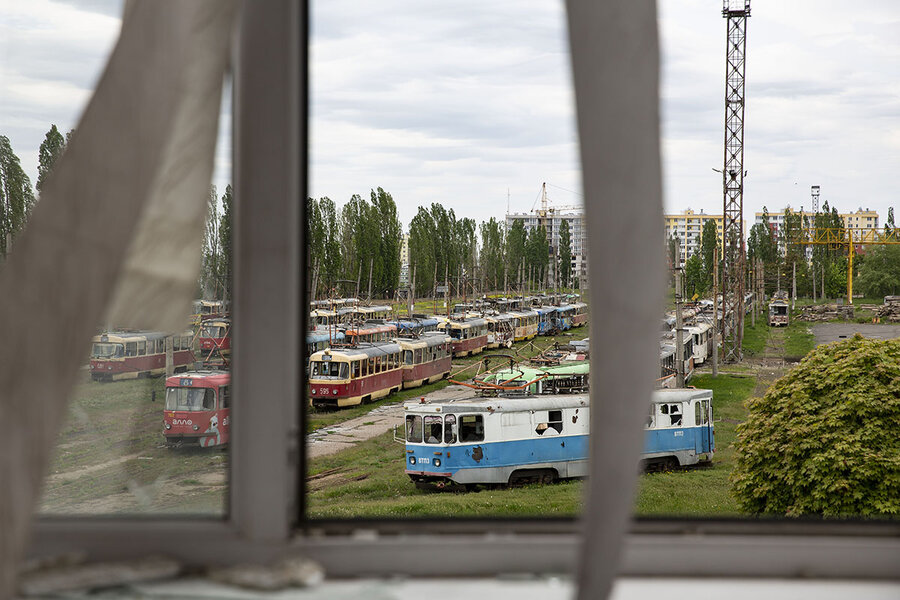Amid war, Kharkiv residents repair city and plan its restoration
| Kharkiv, Ukraine
Slava Zagoruiko walks through a battle-scarred garage in the tram depot on northeast Kharkiv’s front line. “Each hole was a hit – the large ones rockets, the smaller ones mortar or artillery,” the depot overseer says as he points out breaches in the shattered building, a home to old streetcars, including his personal favorite, a wooden tram once featured on movie sets. “The Russians thought this was a Ukrainian army base.”
Now the streetcars in and around the garage are casualties of the war, and present a daunting challenge to cleanup efforts. “Not one of these trams is undamaged,” he says. “If I were the mayor, I would not know where to start.”
But nearby, work is already underway. Dressed in camouflage pants and flak jackets, two middle-aged men coordinate efforts to remove the rubble from a residential district in northeast Kharkiv. Heavy-duty vehicles struggle to clear the twisted metal skeleton of a commercial strip reduced to ashes. Glass shards and debris pave the road.
“Communal services have not stopped working for a single day since the start of the war,” says Yugeny Lipovoy, who is responsible for the city’s transportation services during peacetime. “Most communal workers stayed in Kharkiv. If there was shelling in one stretch of the city, they went to clean up another neighborhood. ... All communal services are operating: trash, gas, electricity.”
That commitment is grounded in the clear-eyed realization that Kharkiv, hollowed out by weeks of heavy Russian bombardment, will remain especially vulnerable as long as the war lasts. Sitting 30 miles from the border with Russia, it will always be within striking distance.
Experts say it could take years, perhaps decades, to restore Ukraine’s second-largest city to what it was. But community workers and volunteers are focused on making the present livable for those who remain, many of whom still shelter in underground bunkers, metro stations, or the relatively safer pockets in the center and southwest of the city.
“From the moment it starts, reconstruction could take three to four years,” says Kateryna Kublytska, an architect documenting damage to heritage buildings. “The sleeping districts will take at least 10 years. The question is when will reconstruction start. From a restoration perspective, we have not had such a challenge since World War II.”
“I feel so sorry for this city”
In northeastern Kharkiv, swathes of the so-called “sleeping districts” – Soviet-era residential areas originally intended to offer little more than space to rest – are a wasteland of disfigured buildings left without electricity. But the retreat of Russian forces just beyond striking range in May opened a precious window of opportunity to coordinate cleanup efforts in the hard-hit sleeping district of Saltivka.
Armed with a broom and dressed in a bubblegum-pink vest, Nadiya Antonova was one of those trying to clean up, clearing smaller chunks of rubble from a highway.
Peace has been elusive for her. She moved to Saltivka from the eastern city of Luhansk, which has been gripped by war since 2014, when Russia annexed Crimea from Ukraine and backed an armed uprising in parts of the eastern Donbas region. And she moved to the city center to live with her daughter and grandchildren on Feb. 24, the day Russia launched its full-scale assault on Ukraine.
“We were running away from war, and war followed us,” says Ms. Antonova, a welder by training. “I feel so sorry for this city. We love it so.”
Moving in with her daughter proved a good call. Russian rockets and bombs have rained down on Saltivka. Its residents, numbering in the hundreds of thousands, have fled in an exodus that, by most estimates, emptied half of Kharkiv, a city of 1.4 million people.
“Nobody really knows how many people have died here because there are still people under the rubble,” says Nataliya Zubar, who for weeks has been cataloging the large-scale destruction with geolocation and videos for each affected structure, in the hope that Russia will eventually be held accountable for indiscriminate attacks against civilians.
“Thousands of buildings have been destroyed,” says Ms. Zubar, sitting in her apartment overflowing with art, books, and photos. “Aerial bombs dropped as the Russians tried to enter the city left deep craters. We’ve even been hit by ballistic missiles fired from the Black Sea. Now the air defense system around Kharkiv is much better.”
History and reconstruction
Kharkiv was badly damaged during WWII. Experts at the time estimated it would take 60 years to rebuild the city, says Ms. Kublytska, the architect. That calculation proved accurate in the sense that Kharkiv only began booming economically in the early 21st century.
Now more than half the population has fled; businesses are shuttered; only a couple of restaurants open their doors in days kept short by curfew. Nearly 3,000 out of 8,000 civilian buildings have been damaged or destroyed in this city, according to official figures.
Missile strikes destroyed the city hall, a shopping center, and the economics building at the V.N. Karazin Kharkiv National University. More than 100 historic buildings have been damaged in this city founded in 1654. They span architectural styles ranging from the undulating lines of art nouveau to hard-edged constructivist structures like the iconic Derzhprom, a white building complex doubling as a reminder of Ukraine’s Soviet past.
Rebuilding, says Ms. Kublytska, can only start when people feel safe enough to open their shops and put their children in school again.
“The city will be restored and rebuilt, history shows that,” she says. “To predict when and how this will happen and how long it will take is hard to say now. This is a new world for us. ... I don’t know if the day will come when we say there is peace now. I am sure the situation with Russia will take many years to resolve, and it is hard to predict how it will affect Kharkiv.”
A ruined mansion with a statue out front
For now, women like Olha Diominova, who worked in a textile factory making stockings before retiring, feel safer underground. The buildings around the humid basement she shares with four families are in ruins. The windows of her own home were blown open early in the conflict.
“When things are calmer, I will go home and try to fix things,” she says. “I don’t know how long it will take to repair everything but we still need to live somewhere. It is hard mentally to live within four walls in the dark, with no windows – to come out only to hear shelling and shooting and not know what will come next.”
The destruction spills into nearby villages fought over by Ukrainian and Russian troops. One Russian attack that sparked local fury was a rocket strike that destroyed the museum for Ukrainian Cossack philosopher Hryhorii Skovoroda, located in Skovorodynivka. The 18th century building caught fire, destroying most of the structure except for parts of its yellow facade and stately pillars.
“When I think about all the plans we had for this place, I feel there is no war,” says Hanna Yarmish, the museum’s elderly custodian who, along with her husband, hoped to open a cafe to host philosophical discussions.
“Then I approach and I am shocked,” she says, pointing to the ruined mansion framed by a forest of oak and apple trees, where birdsong drowns out the rumble of incoming and outgoing fire. “By targeting this museum, they were trying to break our spirit and rob the world of a philosopher who upheld the principles of living in peace and love.”
She puts her faith in the power of nature to restore, and she treasures all that remains: Skovoroda’s grave, a collection of sculptures, a pond full of industrious beavers and chatty frogs, and, best of all, a statue of the philosopher himself that was propelled out of the museum by the blast and now stands unscathed in front of it.
“This war will end,” declares Ms. Yarmish with confidence. “We will rebuild and fix everything up.”
Reporting for this story was supported by Oleksandr Naselenko.






